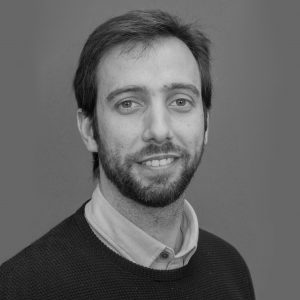Each year we invite IB alumni to share their experiences, interests and advice with our global community in the graduate voices series. We welcome Diploma Programme (DP) graduate Xavier Bofill De Ros, who shares his journey into a profession in the sciences and more about his work with gene therapy.

Perhaps all scientific callings begin in childhood; the natural curiosity that children have leads them to question everything around them. My own scientific awakening was like that too. I remember watching Sunday afternoon animal documentaries on TV at my grandparents’ house filled with fascination. I also remember devouring my first popular science book that my grandmother gave me entitled “What Einstein Told his Barber,” by Robert L. Wolke.
Later, I began playing with my first microscope, looking at a magnified world through its lenses; the wing structures of a fly or the leaves I had picked up from the garden. Although biology seemed more appealing to me, as it would to any Renaissance man or child, curiosity is not bound by scientific disciplines. Playing with my chemistry kits, I watched with astonishment as beautiful sky-blue crystals of copper sulphate formed and I saw how candles consumed the oxygen around them. All this in the makeshift laboratory of my parents’ kitchen. I still keep the notebook where I wrote down all these little discoveries.
“It was clear to me that I wanted to do research, to see first-hand what is not yet written in textbooks.”
Some people have their future all mapped out from an early age, but not me. In my family, nobody had a background in science; everyone had either studied humanities or business. It wasn’t until high school that I began to seriously think about what I wanted to study at university. Here I must thank Mr. Montoliu, a strict, almost military-like teacher, but someone who was passionate about sharing his knowledge of chemistry and biology with his students. I spent many hours a week with him in one or the other of his classes, either the International Baccalaureate laboratory practicals or the after-school team that he coached to prepare us to compete in the Chemistry Olympiad.
Two of us qualified that year at the regional stage and went on to compete nationally! Mr. Montoliu was proud of the certificates he had in his office for all the years his students had qualified for the national final. He was like one of those heterodox teachers you see in movies. Thanks to Mr. Montoliu, I applied for my first scholarship to begin my research project with the help and mentorship of Dr. Bañeras, a professor of microbiology at the university. That scholarship enabled me to obtain the resources and the support I needed to isolate spores from different species of moulds found in the air and on the surface of household objects. I was able to then use the spores to cultivate the fungi in Petri dishes and study their growth on different substrates and in varying environmental conditions. All this made me choose, fairly decidedly, to begin a biology degree at university the following year.
During my first two years at university, I felt a little bit lost. For every calling there are times of uncertainty. Even though my classes and my grades were fine, I wasn’t sure if I was studying the right thing. When you choose a major, you focus on one area, but I felt that maybe I was missing out on a lot of other things. I wanted to learn more and, partly because of that and partly because of a girl I liked, I decided to enrol in a few chemistry classes in my second year. And for my third year, I moved to a new city, transferred my credits to the University of Barcelona and enrolled in the second half of their biochemistry degree.
“In my family, nobody had a background in science; everyone had either studied humanities or business.”
This leap in the dark proved to be a good decision. The environment there was stimulating because the second half of biochemistry brings together students majoring in medicine, biology, chemistry and pharmacy, and the study of molecular biology and biomedicine becomes more intense. With the change of city, I also went to live in a university residence, where I made friends who were studying all sorts of degrees. The conversations during our lunches and dinners ranged from politics to physics to art history. That’s where I found my perfect fit.
I’d already done laboratory practicals in the plant physiology department and for a few summers I participated in an exchange programme abroad on human genetics, but it was during the last year of my degree that I worked in the laboratory of Dr. Cascante. There, on the top floor of the chemistry building, we studied how tumour cells adapt their carbohydrate metabolism to support the high rate of cell division that’s characteristic of tumours. At that moment, I felt that I had clicked with oncological research, having also recently experienced cancer close up in my own family. It was clear to me that I wanted to do research, to see first-hand what is not yet written in textbooks.
Since finding an exciting line of research to devote the next few years of my professional career was no easy task, I wrote to several groups. In the end, however, I “went for it” and joined Dr. Cristina Fillat’s research team at the Centre for Genomic Regulation (CRG). Her group is studying the use of gene therapy with oncolytic viruses in search of a possible treatment for cancer, namely how to harness for therapeutic purposes the ability these viruses have to penetrate cells, to replicate hundreds of times, and then to lyse the host cell in order to continue infecting new cells. Our objective was to modify the genome of these viruses so that their lytic activity was only used on tumour cells.
I specifically worked on the concept of using microRNAs as a selection mechanism. MicroRNAs are very small RNA molecules (containing about 22 nucleotides) whose function is not to produce proteins but to regulate genes through the recognition of complementary nucleotide sequences. By modifying the viruses to target microRNAs, I was able to prove that virus replication could be neutralized in normal liver and pancreatic cells while leaving the virus fully active in tumour cells. In addition, I also studied the role of some of these microRNAs to understand how they contributed to the onset of cancer. In particular, I was able to see how their loss of expression increased cell motility, suggesting a potential role in the migration of tumorous cells which generate metastases in distal organs.
The atmosphere in the laboratory was great. I consider all my peers great colleagues and friends; together we shared both the frustration that science sometimes generates and many, many laughs. But, as they say in the theatre, “the show must go on,” and so my scientific career must go on.
“This new phase of research is full of new challenges and responsibilities”
After defending my doctoral dissertation, I began to look for my next professional challenge. I considered some options outside of the academic world, given the instability of work in the scientific field, but ended up pursuing further postdoctoral research in the United States. There, I joined the National Cancer Institute (NCI) in the laboratory of Dr. Gu, a young researcher who had just started his group after a successful postdoctoral stint at Stanford University. I’m still here studying the biology of microRNAs, deciphering the mysteries surrounding how these small RNA molecules are generated, and how seemingly insignificant changes at their origin can dramatically change their function. This new phase of research is full of new challenges and responsibilities, such as mentoring the new generations of scientists who are just starting out, developing research projects and establishing scientific collaborations with other researchers and companies.
But beyond the frenzy of this new phase, there is also time to meet people from all over the world, and to get to know our host country and its culture. This is how I met Zhenyi, a postdoc peer working on profiling the role of neurotrophic receptors in non-neuronal tissues. We both share the same passion for science and much more. Recently we got married and we’re looking forward to starting a family together. I’m telling you all this to explain how a scientific calling, at least mine, anyway, can grow and mature with time and be influenced by the people encountered along the way. And as the poet Antonio Machado wrote:
“Caminante, son tus huellas
el camino, y nada más;
caminante, no hay camino,
se hace camino al andar.
Al andar se hace camino,
y al volver la vista atrás
se ve la senda que nunca
se ha de volver a pisar.
Caminante, no hay camino,
sino estelas en la mar.”
“Wanderer, your footprints are
the path, and nothing else;
wanderer, there is no path,
the path is made by walking.
Walking makes the path,
an on glancing back
one sees the path
that must never be trod again.
Wanderer, there is no path,
just your wake in the sea.”

Xavier Bofill De Ros received his IB diploma from Bell-lloc del Pla in Girona, Spain. He continued his studies with a double degree at the University of Barcelona and a master’s at Pompeu Fabra University. During his PhD, he worked on engineering viral vectors for gene therapy. Currently, he is at the National Cancer Institute, understanding the role of miRNAs on gene regulation. On his free time, he likes reading from science to art and volunteering in a local NGO. You can connect with him on LinkedIn here.
To hear more from Diploma Programme (DP) graduates check out these IB programme stories. If you are an IB grad and want to share your story, write to us at alumni.relations@ibo.org. We appreciate your support in sharing IB stories and invite you to connect with us on LinkedIn, Twitter and now Instagram!
If you enjoyed this story, consider reading more below:



